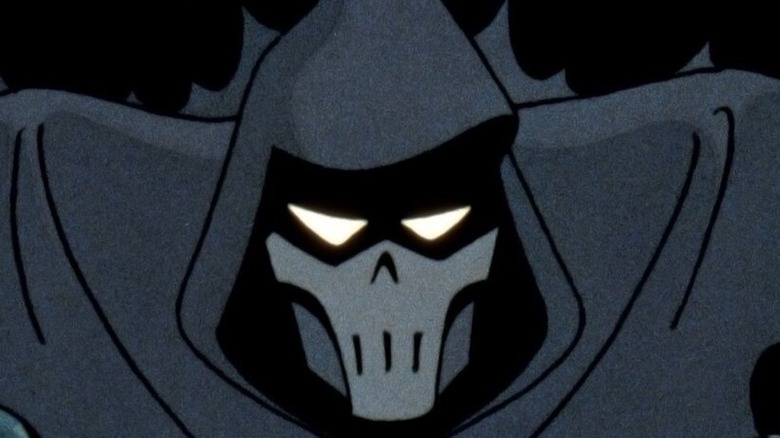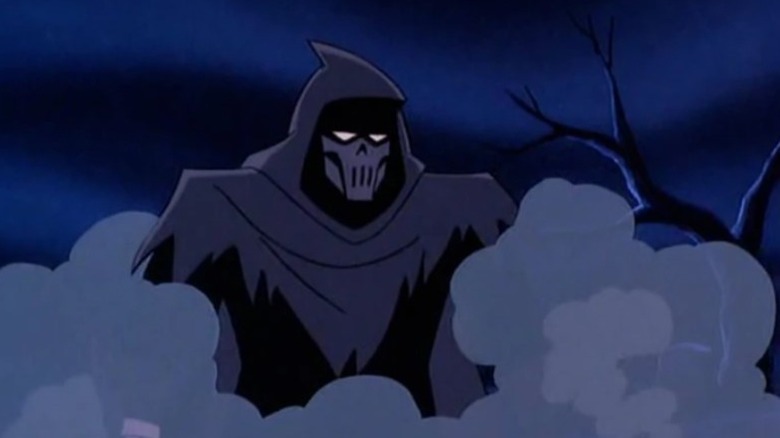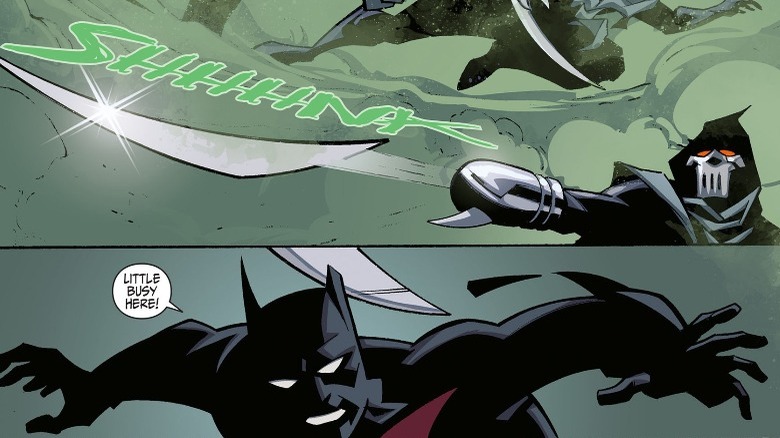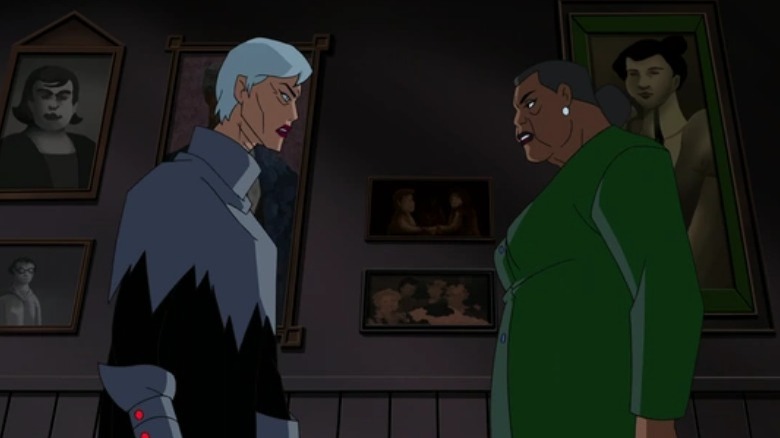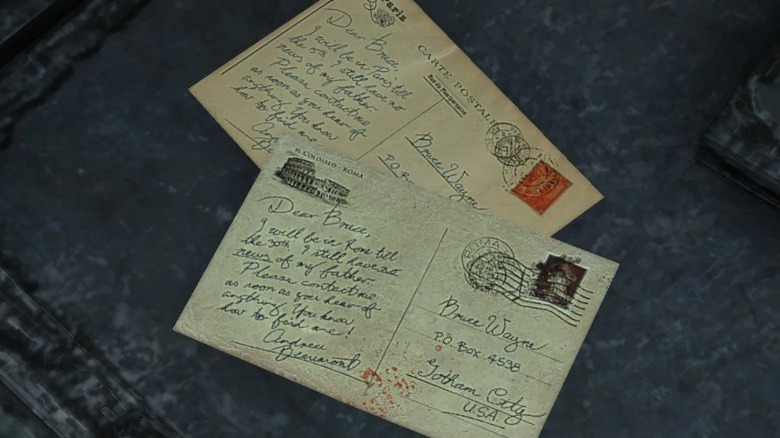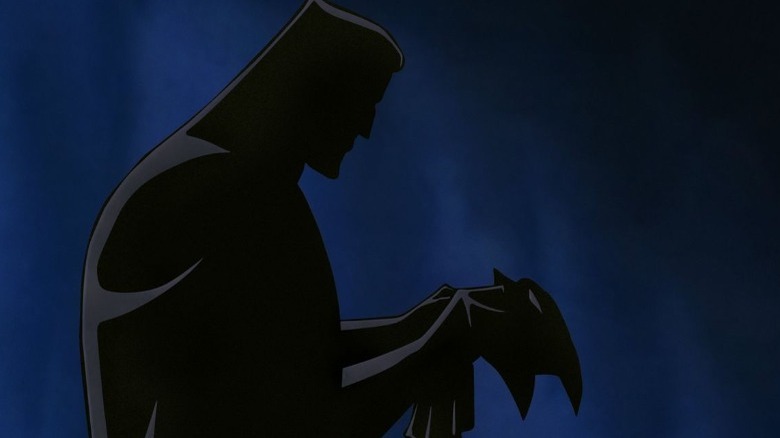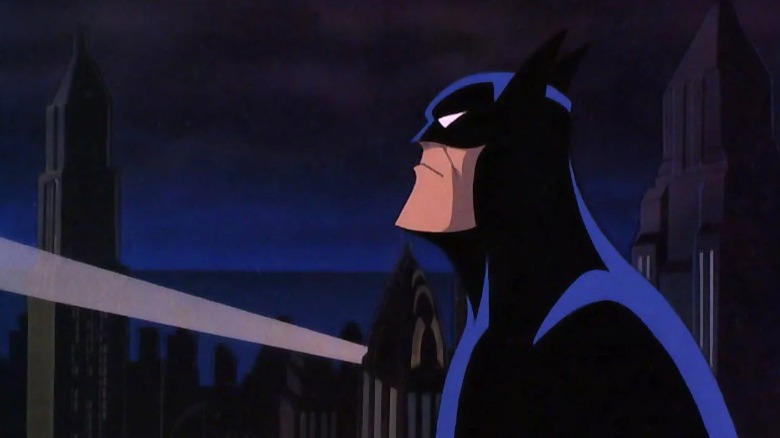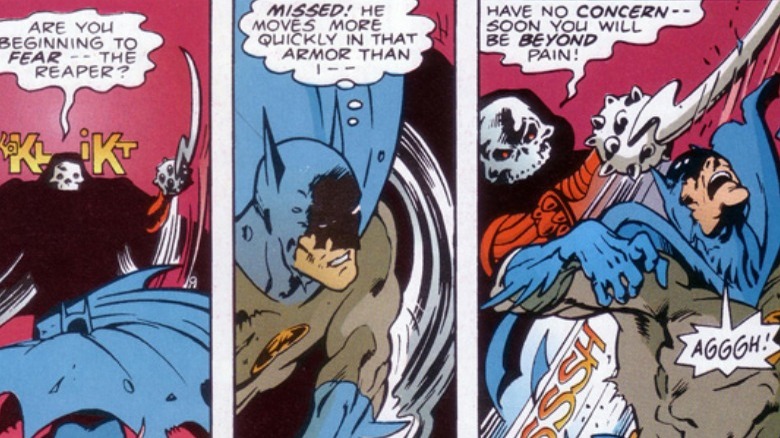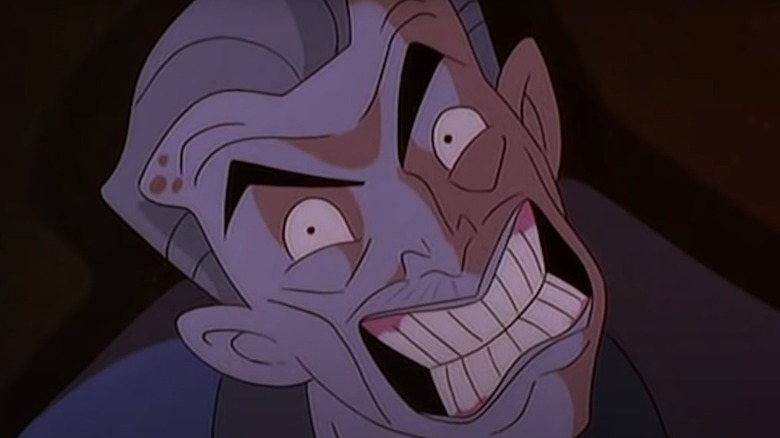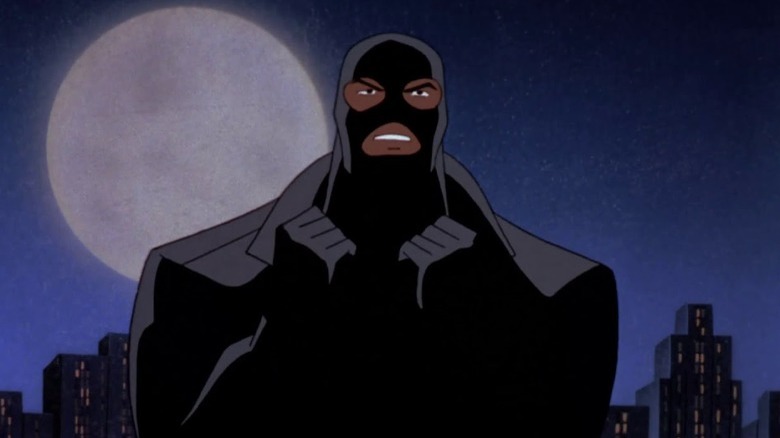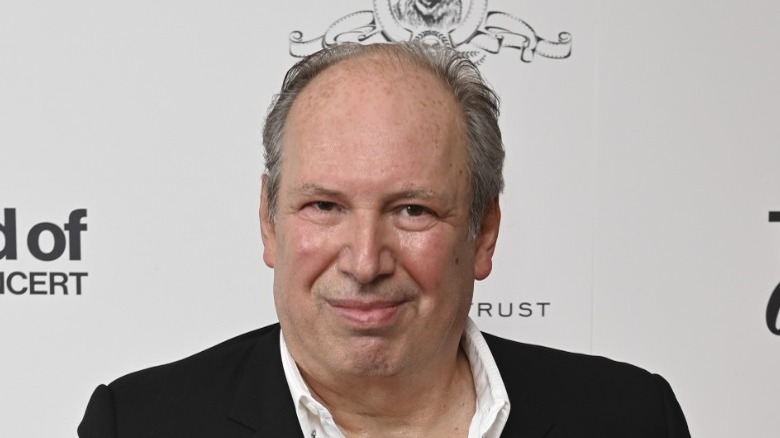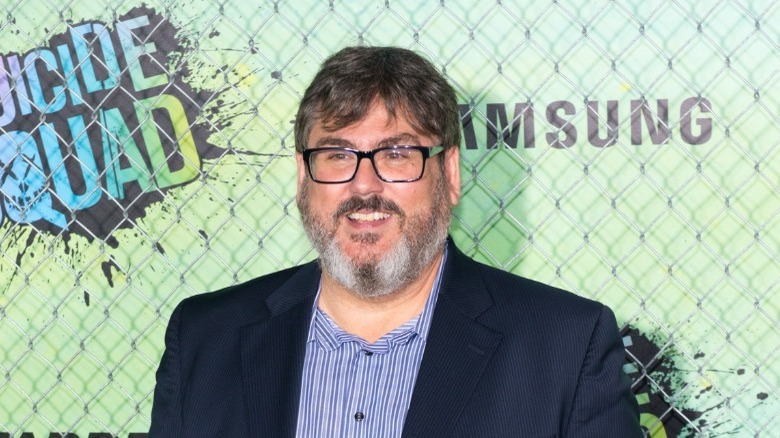Batman: Mask Of The Phantasm: Details Only Huge Fans Of The Caped Crusader Know
"I didn't count on being happy," Bruce Wayne solemnly explains to the gravestone of his long-deceased parents. It's the plight of a young man who'd promised to hold the underworld of Gotham accountable. But his soul is laid bare in the wake of the greatest of human experiences: love. "Batman: Mask of the Phantasm" extends the mythology of the Caped Crusader into an intensely personal story with an unthinkable twist that is only bound to leave a mental scar on the tortured hero for the rest of his days. To this date, "Mask of the Phantasm" is revered as one of the most insightful deep dives into Bruce's personal tragedy and the whirlwind conflict within his soul. It features the vocal talent of Batman personified by the late, great Kevin Conroy.
The film introduces a new killer amid the pantheon of Batman villains in the form of the Phantasm, a name the mysteriously cloaked figure is never called in the film. Only, the Caped Crusader never counted on the vindictive murderer to be the "one who got away." Andrea Beaumont (Dana Delany) once laid claim to Bruce's heart. In his attempts to reconcile the cyclical fight within himself to better Gotham and his longing for true companionship, Andrea leaves Gotham making Bruce's choices infinitely easier but his pain much deeper. His parents never demanded that he be Batman. The gravestones are merely a proxy for his own mental demands. "Phantasm" is much more than an animated Batman film. It's a character study of pop culture's most iconic heroes. Let's examine some of the lesser-known details surrounding the film and its production that, perhaps, only the biggest fans may be aware of.
The Phantasm is an original creation by Alan Burnett, Bruce Timm, and Paul Dini
"Batman: The Animated Series" ushered in one of the best depictions of the Dark Knight in modern history. The neo-noir landscape that Bruce Timm and Paul Dini created for the vigilante became the foundation for many of the most iconic Batman stories. In fact, many popular Batman characters were ultimately shaped and molded by the series. For instance, Mr. Freeze's tragic backstory in the episode "Heart of Ice" is an original work that became a mainstay intrinsically tied to the character in future Batman productions.
Fans who are just watching "Mask of the Phantasm" for the first time nearly three decades after its release might be surprised to learn that the film's central villain, the Phantasm, is actually an entirely original creation for the film. While the character may have had some inspiration from "Batman: Year Two" and its villain, the Reaper, Alan Burnett, Timm, and Dini developed the story of Andrea Beaumont and her killer alter-ego from scratch. Not only is the villain something totally fresh, but Andrea's position as Bruce's love interest stands in stark contrast to the character's other romantic relationships in his long, fictional history. Bruce's affection for Catwoman often reminds him there is a vast grey area when it comes to guilt and innocence. Talia al Ghul was another "bad girl" fling that only drew a deeper connection between Batman and the League of Assassins. However, Andrea is positioned as a woman who is guided by her own personal tragedy just as much as Bruce is. In fact, much of her rage is founded on having to leave her happiness with Bruce behind. She's a remarkable addition to Batman's legacy.
There are multiple comic book sequels
While the Phantasm largely never made a major resurgence outside of the animated film, aside from one episode of "Justice League: Unlimited," there have been a few comic book realizations of the character. Some of these are technically sequels to the animated film. Of these storylines, there is one that is deemed canon within the DC animated universe. "Shadow of the Phantasm" is an annual issue of the "Batman & Robin Adventures" series that was released in 1996. While the introduction of the story picks up right where the film left off, there's a time jump three years into the future depicting the Phantasm's return to Gotham in order to prevent an assassination attempt on Bruce Wayne. It's a fun, brief sequel that sheds light on what Andrea has been up to in the years that followed the events of the film.
A sequel then set in the distant future of the "Batman Beyond" world came to fruition with the storyline "Mark of the Phantasm." This is part of the "Batman Beyond 2.0" comic series. In the story, A.R.G.U.S. meddler extraordinaire Amanda Waller sends Andrea on a mission to assassinate a man by the name of Jake Chill. If the surname sounds familiar to you, that's because he's a relative of Joe Chill, the man who murdered Bruce's parents. Jake Chill, ironically enough, murdered Terry McGinnis' parents. Originally intent on turning Terry into the proper new Batman, she asks the Phantasm to remove Jake Chill from being a temptation for Terry to take vengeance upon, ultimately causing him to turn his entire attention to the crusade of being Batman. It's typical Waller manipulation DC fans have come to expect. But it also offers a chance to see a much older and just as lethal Andrea Beaumont return as the Phantasm.
The Phantasm returned in Justice League: Unlimited
In the distant future, Bruce Wayne gives up the cowl after realizing his aging body simply can't keep up with the criminals of Gotham City despite the aid of a high-tech Batsuit. He recruits Terry McGinnis to mentor as the new Batman of Gotham City. This is the premise of "Batman Beyond" that began with an animated television series at the turn of the century. Since then, plenty of new connections have been made in the DC animated universe to Bruce Timm's future world as seen in "Batman Beyond." The "Justice League: Unlimited" series dabbled in time travel and saw the return of Terry McGinnis on occasion. In the final episode of the second season, entitled "Epilogue," we learn how fated Terry's turn as Batman really was.
Just like "Mark of the Phantasm," Amanda Waller shows her meddling nature once again as she reveals her attempt at creating the new Batman successor following Bruce Wayne. It's revealed that Terry was, in fact, created with Bruce's DNA despite being birthed (by surrogacy) to other parents. This was the first step Amanda took to ensuring Batman's legacy would live on. She also determined that tragedy was a defining factor in the Caped Crusader's life. In an effort to mirror that major variable in Bruce's story, she commissions the Phantasm to have Terry's parents murdered. Ultimately, Andrea backs out of the job, but that doesn't stop Terry's parents from being murdered down the road (interestingly, not by Waller's hand).
The Arkham Origins video game references the Phantasm storyline
Kevin Conroy's vocal work as the Batman didn't stop with television and film animation. The actor was brought on to help bring Batman to life in a trilogy of Batman games centered around Arkham Asylum and its legacy. However, there is one Arkham game that didn't feature Kevin Conroy as the voice of Batman and instead hired Roger Craig Smith. It's a prequel set in Batman's younger days. It's also the game that references the iconic DC animated story "Mask of the Phantasm" in a blink-and-you'll-miss-it Easter egg. The game, entitled "Batman: Arkham Origins," tells the story of Bruce Wayne early in his career as the Caped Crusader attempting to stop multiple assassins gunning for him on Christmas Eve.
Inside the Batcave, there's a litany of items that Batman can inspect. On one workbench, players can find two postcards sent by Andrea Beaumont. They're both from Europe and indicate that she is searching for her father. Of course, this sets up the tragedy that is yet to unfold as we know it in the "Mask of the Phantasm" storyline. It seems, that in the video game Arkham universe, the Phantasm is one villainous adventure yet to be seen on the horizon.
Mask of the Phantasm maintains a high honor at the Annie Awards
Very rarely do superheroes get a chance to shine at the Oscars, let alone an animated superhero affair. While the Academy does have categories to recognize animated features, the production of the awards show rarely focuses on the genre. That's where the Annie Awards come in. Of course, the name "Annie" is a derivation of the term animation, as these awards expressly focus on the talent that goes into animated productions. The Annie Awards first began in 1972 at the behest of voice actress June Foraym who has voiced many animated characters over the years, including Rocky the Flying Squirrel, Jokey Smurf, and even the Granny in "Looney Tunes" among countless others.
Often, the Annie Awards would be populated with Disney animated productions and popular cartoon films. Now, Illumination Entertainment (famous for "Despicable Me"), Disney's Pixar, Dreamworks, and Warner Bros. Animation productions are featured among the nominees year after year. For the longest time, however, comic book-based superheroes were absent from the line-up. "Batman: Mask of the Phantasm" is the first superhero film to receive a nomination for Best Animated Feature. Of course, it lost to Disney's "The Lion King." It was the only comic book film nominated for best feature at the Annies until "Spider-Man: Into the Spider-Verse."
It's the first DC Animated Universe film
"Mask of the Phantasm" certainly pushed a few boundaries. It became the first Batman animated feature film to be shown on the big screen, and it also tied into a very popular ongoing TV series at the time. In addition to being the first film that put animated features inspired by comic books on the map with regard to the Annie Awards, it was also the first movie to kickstart a sprawling animated universe interconnected with other DC properties aptly known today as the DCAU (DC Animated Universe). Famously, the DCAU began with "Batman: The Animated Series" and went on to include "Superman: The Animated Series," "The New Batman Adventures," "Batman Beyond," "Static Shock," "The Zeta Project," "Justice League," and "Justice League Unlimited."
As far as other feature films in the DCAU that'd follow "Mask of the Phantasm," notable Batman-related films include "Batman & Mr. Freeze: SubZero," "Batman Beyond: Return of the Joker," "Batman: Mystery of the Batwoman," "Batman and Harley Quinn," and "Justice League vs. the Fatal Five." The DCAU stretches beyond animation to countless comic book storylines as well. However, a certain reverence must be paid to "Mask of the Phantasm" for not only being the first feature film in the sprawling universe but for also being the only one to ever be shown in theaters.
Mask of the Phantasm is loosely based on Batman: Year Two
In 1987, a storyline emerged in "Detective Comics" starting with issue #575, entitled "Batman: Year Two." It ran for four issues. The narrative involves a woman by the name of Rachel Caspian, a philanthropist, who gains the attention of Bruce Wayne. They develop an intimate relationship as the Dark Knight falls head over heels for her and even proposes, mirroring Andrea in "Phantasm."
This story isn't entirely well-known mostly because Batman takes a very un-Batman-like approach to his confrontation with an anti-hero known as the Reaper. The Reaper happens to be Rachel's father, who is slaying crime bosses left and right. Batman becomes so fixated on taking down the Reaper that he actually works with crime lords to stop the villain (anti-hero?), ultimately cooperating with his parents' killer, Joe Chill. While simultaneously dating Rachel as Bruce Wayne, he plans to murder Joe Chill as Batman once their cooperative efforts to take down the Reaper are finished. You read that right. If any part of this does sound familiar though, perhaps, it's because Christopher Nolan seemingly borrowed the name of Bruce's love interest, Rachel, and Bruce's desire to murder Joe Chill for his 2005 film, "Batman Begins." But here, at least, Bruce wasn't yet Batman when he plotted to kill the man.
While "Year Two" never takes the "Mask of the Phantasm" twist where Bruce's love interest is also the enigmatic villain, not her father, it still seemingly laid the groundwork for the reworked storyline under Bruce Timm and Paul Dini's stewardship. "Phantasm" thoroughly fleshes out Bruce's state of mind and stays in line with the mythos of the Caped Crusader far better than "Year Two" ever did.
The film depicted violence that the TV series never could
While "Batman: The Animated Series" adapted the more dark and brooding tone of Batman that began to rise in media due to the popularity of Tim Burton's 1989 film, "Batman," there were still plenty of areas that the show could not tread given the restraints of TV shows airing for young children in the early '90s. Death is largely never seen in the show. In fact, allowing the series to display real-world firearms was edgy for the time, even if no one was actually killed on-screen by one. However, "Mask of the Phantasm" enabled the filmmakers to take things a step further not being tied down by common regulations set for TV.
The Washington Post remarked in their review of the film that the violence depicted is heavier than anything seen in the animated TV series. Now, don't get us wrong, "Phantasm" is merely a stroll down the yellow brick road compared to Batman productions of today. But for the time, disturbing imagery like the corpse of Sal Valestra's (Abe Vigoda) contorted body wildly smiling from ear-to-ear is the stuff of nightmares, especially for young children. Murdering crime lords, despite the feel-good vindictive nature of it, isn't exactly an adventure for innocent eyes.
Batman Begins pays homage to Bruce Wayne's earlier crime-fighting days in Mask of the Phantasm
"Phantasm" depicts Bruce in his pre-cowl-wearing days — the prelude to the eventual rise of the Batman in Gotham City. Of course, Bruce had to take some time to figure out how he planned to carry out his own personal vow to combat crime and corruption in Gotham. Before recognizing that he needed to embody a symbol of fear toward the evil-doers he encountered, he was just a simple guy in a black ski mask. He pummels a number of lowly thugs but realizes that after the fight, they had no problem jumping into the fray given that he looked like some ordinary schmuck off the street. The idea is that they didn't fear him. However, the ski mask is an accessory some eager Bat-fans may recognize from another popular "Batman" adventure.
In Christopher Nolan's "Batman Begins," Bruce wears a ski mask here as well before developing the cowl. But instead of the jacket and jeans seen in "Phantasm," the "Begins" version of Bruce is already decked out in combat gear that he's been field-testing for each new crime-fighting occasion. Still, it leaves viewers to wonder if the ski mask was a true-blue reference to "Mask of the Phantasm" by the filmmakers of "Batman Begins." Definitively, there's never been any confirmation of the intent by Nolan or the producers regarding the mask. Still, given that these are the two primary instances depicting Bruce in a ski mask going to town on some thugs, there's no reason to not see it as an homage to the extraordinary 1993 animated film.
Famed composer Hans Zimmer held a role in the musical score
Batman fans know the music that accompanies his adventures all too well. If "na na na na na na na na Batman!" popped into your head, then you're from a much more seasoned generation. We're talking about the reverberating bass tones and horns that signal the mysterious masked avenger as he broodingly contemplates his next move atop a gargoyle on a building in the middle of downtown Gotham City. Whether it's Danny Elfman's iconic theme that was developed for Tim Burton's 1989 film or the later Hans Zimmer score that'd magically create a stir in the pit of all our stomachs with the swelling ring of only two notes, Batman's themes are unmistakable. Despite the differences between the themes, there's one big similarity: They each manage to capture the gothic nature of a hero donning the guise of a creature of the night. It's almost inexplicable, but you'll know it when you hear it.
Speaking of Zimmer, the famed composer whose body of work spans countless films in the modern age, some might be surprised to learn that Christopher Nolan's films were not his first experience with producing music for the Caped Crusader. In "Phantasm," long before he became a big-time composer, he filled a chair in the music department as a synthesist. Zimmer had already been composing for films like "Cool Runnings," "A League of Their Own," and "True Romance," and he'd worked on more famous films like "Castaway" and "The Last Emperor," but he hadn't yet gotten his first defining project — that came a year after "Phantasm" with "The Lion King." Perhaps, his experience on "Mask of the Phantasm" gave Zimmer the idea for reinventing the Batman theme song for the Dark Knight's live-action reimagining.
Writer Paul Dini was brutally mugged during the production of the film
Sadly, Paul Dini, one of the primary writers and creators behind both "Batman: The Animated Series" and "Mask of the Phantasm," suffered a brutal mugging during the making of the film. In 2016 in an interview with ABC News, he relayed the horror of his near-death experience: "[They] grabbed me and beat me so badly I nearly died." He continued, "They took a great amount of pleasure in doing it and they said they were going to blow my head off and to count and wait for the shot." But they didn't fire a fatal shot. It was all meant to terrify Dini, and they left him lying in the street nearly dead. Afterward, he had to undergo extensive facial surgery to repair the damage.
The moment almost ended his involvement in "Mask of the Phantasm" entirely. "I can't write power fantasies about a hero who comes to everybody's rescue where there was no hero in my life," he said. But ultimately, his perspective shifted. He saw his work as important, the role of superheroes in comics and TV as an ideal people need in their lives. He channeled his anger and darkness in the wake of the attack into his work, understanding that it is the idea of heroes and what it means to become a hero that truly matters. Thankfully, Dini finished his work with "Phantasm" and continued working with Warner Bros. Animation until leaving the company in 2004.
